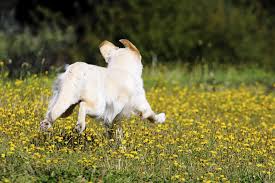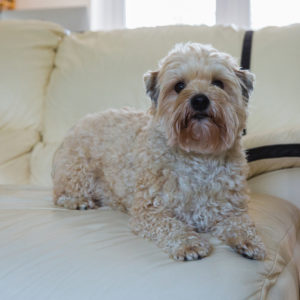Fear on the Walk – why some dogs are difficult

Fear on the walk – why are some dogs difficult? Yesterday, whilst walking with our dogs in the park, we came across a small dog running loose. When one of our dogs approached her, displaying a play bow, she bolted and ran straight into the path of a post office van. Luckily the van stopped in time but she ran down the road and disappeared. We found her later quivering at the edge of a football field. It took a great deal of patience to retrieve her. The owners explained she was a puppy farm rescue and that she hated going out for walks. She was very fearful of the outside world and especially of other dogs. The owner picked up the dog, called Bella, and fussed her. I suggested the owner put her back on the ground and not reward her fearful behaviour, but she declined.

Poor communication skills
Both our dogs are very friendly and it would have been a good exercise to introduce Bella to our submissive friendliest dog Jazz. He was the one who displayed the play bow. Unsocialised dogs, especially those from puppy farms, have poor communication skills. Although Jazz was inviting Bella to play, she had no idea what he was saying and legged it through fear.
Walking with another dog
I did try to explain why her dog was fearful but the owner was so upset, she didn’t really hear me. It’s a shame; I have not seen her since this event. A good walk with her and her little dog, myself and Jazz would certainly help Bella and her owner to relax. I’m sure if I took Jazz with me, some of the fear in them may dissipate and they both may start to enjoy their walks.
Don’t reward fearfulness
I think this little dog will always have fear issues unless the owner seeks professional help. In my humble opinion, Bella should be introduced to as many calm and friendly dogs as possible, as well as other situations to counteract events that make her fearful. Rewarding with affection for being fearful, will only maintain that fear.
Bella should be introduced to as many calm and friendly dogs as possible, as well as other situations to counteract events that make her fearful. Rewarding with affection for being fearful, will only maintain that fear.
Dogs do not react like children
We have to remember, dogs are not children. Children benefit from being comforted after a cut knee or an unpleasant experience. Dogs, on the other hand, do not react the same way. They need to be cajoled by coaxing and cheerful encouragement. It is only when the fear is overcome by the dog, that he should be rewarded. Anything to reinforce calm and relaxed behaviour.
The importance of early socialisation
This is an example of what happens if a dog is not socialised as a puppy. The critical period is 3 – 16 weeks. During the early weeks, puppies should be with their mother and their siblings. 8 weeks is the ideal time to take your puppy home. Taking pups away from their mum too early can have disasterous consequences for the dog’s later life. The dog will likely be difficult to train, may show serious signs of fearfulness and/or aggression. They also may not have learnt about the inhibitive bite. This is something instilled in them by their mother and then reinforced by playing with their littermates.
 What to look out for
What to look out for
If you’re looking for a puppy, make sure you see the mum. The mother should still be there with her pups. If possible, also see the father. Check to see how the litter was brought up. Were they in the family home or were they in a barn or more remote area outside the home. Is the mum relaxed and happy or is she showing fearfulness or aggression towards you. Are the pups playing together. Are the pups inquisitive or are they nervous or disinterested in their surroundings.
Take a picture!
Try and see the pup before you take him home, say at 6 weeks. If you choose a pup, take a picture of it so you can be sure not to be given a pup you didn’t choose. Make sure you image something that distinguishes the pup such as a white foot or marking on the body. Remember, you are very vulnerable when buying a pup, purely because you will likely be smitten and not thinking straight. Be aware! If the breeder tries to encourage you to take 2 pups, walk away. This kind of decision needs to come from you, not the breeder. If the breeder discourages you from buying 2 siblings, that’s a sign of a responsible breeder.

By the way
Speaking from experience, I would discourage taking 2 pups home from the same litter. Apart from the added time needed training 2 youngsters, everything will be twice as difficult. Think about it very carefully if you are considering taking 2 pups at the same time. Do your research and find out the pitfalls as well as the benefits. Trust me, there are more pitfalls than you realise! I would advise you to be patient and wait until your first pup has grown and has basic training, before you take on another.

Very right what you mentioned here about dog training in walking and riding. Surely raising two animals together would disassemble both. I also did not know that you could adopt a puppy during the 8 weeks of his life to allow him time to socialize with his mother. Very useful information and training for developing a dog’s social skills.
Hi Water Life and thanks for your input. Yes puppies should stay with their mother for 8 weeks because she teaches them many important skills including the “inhibitive bite”during that period. Once learnt, the pup will be careful not to bite too hard if he’s playing. A very important skill to learn from his mum and his littermates during those informative 8 weeks. But most importantly, this skill will teach the pup not to mouth his owners.
Humans should also be introduced to small puppies from the age of 3 weeks or so. Any animals coming in contact with that pup at such a young age will be imprinted on him and consequently he will not be fearful of those animals. Those that come to mind are cats, rabbits and other pets. Once you have your puppy, socialization should be an ongoing part of his life, along with habituation and introduction to strange new events and situations to keep the dog confident and inquisitive rather than fearful.